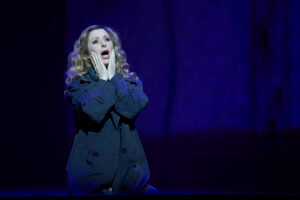W.A.Opera Company and Chorus
His Majesty’s Theatre
reviewed by Neville Cohn

More often than not in opera reviews, comments on the chorus are usually found towards the end of the commentary. But, if ever this group of singers deserves top billing, it’s the W.A. Opera Chorus. I cannot praise their contribution to Carmen too highly. Not only did they sing beautifully – a tribute to guest chorus master Ian Westrip’s detailed training – they were a crucial visual factor in Lindy Hume’s production. The boys’ chorus did particularly well, their mischievous taunting of the soldiers outside the cigarette factory very effective. The soldier choristers, too, were on the ball. Throughout the scene, choral co-ordination was frankly excellent.
Since cigarette smoking has, to an almost total extent, become a no-no in Australia – and this is something to be celebrated – the Act 1 scene in which cigarette girls come outside the factory for a mid-morning fag or two might pose an ethical problem for some. If there are lit fags on stage, are some members of the audience likely to rush out at interval (or even mid-performance) to buy a packet of cigarettes for a hasty puff? I very much doubt it. This isn’t to suggest the chorus smokes real cigarettes while singing the famous song – but surely there are skills enough backstage to provide fake ciggies that look like the real thing – and stage smoke to enhance the impression even more.
As we’ve seen from Hume’s earlier productions of the work, she eschews glamour for its own sake. Verismo is well to the fore. The clothes of the locals look grubby and most of the men look down at heel. There aren’t any government pensions here. Reality is high on the production list and it is almost everywhere apparent – but not in the tavern scene where a ‘dancer’ turns around and around and around – and around. What can this mean? This is the sort of locale where the traditional dance – flamenco – would be as natural an expression as breathing. But the fight scene between Don Jose (Paul O’Neill) and Zuniga (Paull-Anthony Keightley) was effectively choreographed.
The sets are cleverly designed to underscore and enhance the action. The outside of the tobacco factory where Carmen works has a time-worn, tacky look – and that enhances the overall grubbiness of the area, reinforcing an overall impression of a rather rundown, neglected part of town.
Many – most? – productions of Carmen still go to great pains to ensure the eponymous (anti?-heroine) comes across as the apotheosis of a Hollywood siren, a clone of a glamorously garbed Rita Hayworth. Not so here. I recall one of Hume’s Carmen productions of more than 20 years ago in which I commented on Carmen coming across “as charming and mischievous rather than insolent and provocatively seductive”. Milijana Nikolic’s Carmen differs vastly, manner- and appearance-wise. Here is a characterisation that is utterly convincing, a Carmen who is a vulgar tease, a tough-as-nails type, a trouble-maker. It’s a performance that radiates reality.
How very different is Emma Pearson’s characterisation of Micaela. It was spot-on, Micaela’s inherent goodness beautifully evoked, the very antithesis of Carmen’s darkness. Here was a performance of utmost finesse, certainly the most moving I’ve encountered in the many Carmen productions I’ve attended over the last half-century and more. Bravo!
The W.A.Symphony Orchestra was directed with care by Antony Walker.


- All photos except, that of Ian Westrip, by James Rogers.
- Due to illness – and much to my regret – I had to leave midway through the performance.

